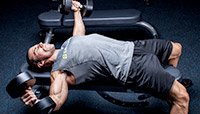With the college football season just ending and the NFL playoffs winding down, the eye of the football world shifts onto the NFL Combine. With the Combine happening the last week of February, players should be fine tuning their training and putting the finishing touches on everything they need to do to open some eyes.
The Combine is where dreams become reality and unknowns become superstars. To better prepare you for this big day, Dave Depew (www.davedepew.com) sat down with Performance Enhancement Specialist Jimmy Smith, CSCS (www.jimmysmithtraining.com) to get to the answers on what athletes needs to do to skyrocket their NFL stock.
Jimmy, before we begin talking about the NFL Combine, why don't you tell the Athletes.com readers some more about yourself.
I have a pretty diverse background. I'm currently pursing my Master's degree in Human Movement and have worked in a variety of athletic settings. I've consulted with US national teams, collegiate athletes, and national level competitors. I'm a Certified Strength and Conditioning Specialist and have also worked in human movement clinics analyzing how people move.
Good stuff. Let's get right into the NFL Combine information. Why don't you tell us a little bit about the NFL Combine tests for those who aren't familiar with them.
The combine evaluates its athletes with 8 tests. Everyone pretty much knows about the 40-yard dash, vertical jump and 225 bench press test but those are always the ones with the most questions so we'll spend more time on them later. There's also the broad jump, 3-cone drill, 20 and 60-yard shuttle as well as position specific tests.
There's always a lot of talk about the 225-bench test and it seems to be controversial. Can you get into it deeper?
The 225-bench test is actually a test of muscular endurance, not muscular strength. It goes back to the old idea that endurance (higher rep) is equal to muscular strength, which it really isn't. The thing about the 225-bench test is that you must go all the way down and touch your chest while finishing with full lockout. The judges are typically strict so they won't allow you to short lockout or bounce the weight off of your chest. You also must keep your butt in contact with the bench at all times.
This is where most approaches fail, the 225-bench press is not a powerlifting event per se. We cannot prepare our athlete to bench like powerlifters, their form must be tight and they cannot skip steps. Any mistake in form and the judges will usually not count the rep; this hurts the athlete big time.
When training for the Combine, athletes need to assess whether they need technique help or strength. There is a big difference, as you come closer to the combine more and more technique work is needed over strength.
So how do athletes go about increasing their bench press for this event?
The first thing athletes can do is testing their strength at different grips. If you watch the Combine you will notice that athletes will usually go with a narrower grip. Most athletes grip the bar the same every time, so training with different grips is a surefire way to get stronger.
The strength of the bench press is a different matter. Athletes need both a maximal strength day and a strength endurance day. We know that enhancing maximal strength will increase every other strength quality as well as muscle size and conditioning.
Getting an athlete fast with his bench press attempts is also another thing trainers can do. Simply timing clean reps and attempting to beat that time is a great way to train.
Athletes also must assess where they are weak on the bench press, if it's the lockout then they need more triceps work. If it's at the bottom they need to get stronger with the chest and anterior delts.
Why do so many athletes have a hard time improving their vertical leap?
In no simpler terms, they don't know how to train for it. During the combine, the athlete needs to focus on their set up and things like the angle of the knee bend and how they reach toward the goal. In training the athlete must determine if they need to be explosive or powerful.
Those are two different abilities. Volleyball and basketball players are explosive meaning that they can repeat the bounce up. Football players will typically be powerful, they can spring one time.
So when I train my football players, they first focus on becoming explosive with more dynamic activities like box jump, single-leg box jumps and the broad jump. While the broad jump is a Combine test, I find by training the broad jump we not only build explosive athletes but also better prepare for the test.
Once the athletes build an explosive base, I then mix in more speed work on their squats and deadlifts. Having an athlete who can squat in the mid 400s or 500s is great but building their squat isn't going to get them that much better, so I focus on more speed or dynamic work.
The problem with vertical jump training is that athletes have a hard time learning how to absorb then transfer their power once they land. To teach the landing I will have the athletes use a 12-inch, then 18-inch then finally a 24-inch box. They only progress when they can sufficiently land.
A good trick for vertical jump technique is having the athlete focus on the arm dip. If the dip is about 15 degrees and as fast as possible then the vertical jump will improve.
javascript:pop('dips-triceps-version')Let's move onto the 40-yard dash. How are athletes going to improve the 40-yard dash?
The 40-yard dash is again another example of technique and strength work. In terms of technique the athlete must start, as close to the line as possible, they must "pull" their arms back with each step. There are so many technique queues that I use with my athletes to make them run faster.
Strength training is again going to be much like the vertical jump. Whatever makes us run faster, will make us jump higher. Athletes need to focus on improved glute function and hamstring strength. For this, they will perform speed deadlifts, heavy deadlifts, unilateral opposite dumbbell deadlifts, box squats & band box squats.
I also make sure that they have their "muscle crossing" working well. Muscle crossing is a term I use to describe the function of the human body that dedicates what happens as one-shoulder affects the opposite leg. If the shoulder isn't functioning, which is likely since we are attempting to improve our bench as well, then we won't run as fast. I'll check the soft-tissue quality and make sure everything with the scapula is OK.
What's one thing that athletes need to know but aren't currently doing?
Once I fix this in my athletes, I see huge 20- and 60- yard shuttle improvements. The athlete must start quick, which will be improved with maximal strength production, and to the side. The biggest factor is that athletes straighten themselves out too quickly; they must stay low the entire race. Athletes are out of control because in these events, they turn too fast and are too high.
Another tip again goes back to maximal force production. Once I improve the athletes' maximal strength, I drop their 40-yard dash. The reason behind this is that after the first few steps, elasticity becomes the main driving force and the athletes' just keeps moving. The stronger and faster we can get them into this elastic phase the better.
Jimmy thanks for your time. Where can the readers find more about you?
Recommended For You

Lose Your Last 10 Pounds - For Good!
Never diet again by incorporating these 10 can't-miss strategies for permanent weight loss.
The Ultimate Beginner's Full-Body Workout
Learn how to train harder and more often, while also maximizing your body's ability to recover, for a quick 10 pounds of clean muscle.
